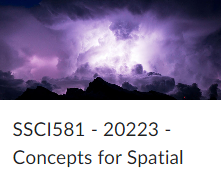SSCI-581-Week15
Big Spatial Data and Geospatial Intelligence
Big Spatial Data
Growth Of Spatial Data - State
- National government agencies collect and store census, remote sensing, land survey, and federal tax data
- State and Local government agencies collect and store myriad data relating to planning, politics and taxation
Limitless Growth of Spatial Data - Capital
- Capital (Private sector)
- Communications: cell phone, internet providers
- Sales: Point of purchase, Point of delivery
- Social Media
The 6 Vs of Big Data
- Volume
- Variety
- Velocity
- Veracity
- Value
- Variability
Characteristics of Big Data
- Huge in volume, consisting of terabytes of petabytes of data
- Hight in velocity, being created in or near real time
- Diverse in variety, being structured and unstructured in nature
- Exhaustive in scope, striving to capture entire populations or systems
- Fine-grained in resolution, aiming to be as detailed as possible, and uniquely indexical in identification
- Relational in nature, containing common fields that enale the conjoining of different data sets
- Flexible, holding the traits of extensionality (can add new fields easily) and scalability (can expand in size rapidly)
Types of Big Data
- Directed
- Automated
- Volunteered
All articles in this blog are licensed under CC BY-NC-SA 4.0 unless stating additionally.
Comment


